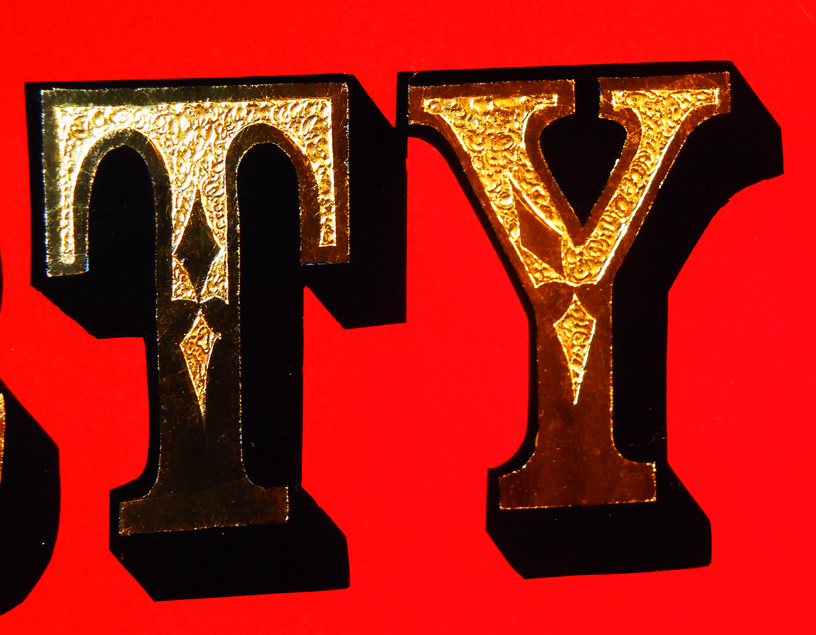Artists and sign makers have used Damar Varnish for various applications, including encaustic wax painting, varnishing oil paintings and glass gilding. In this story, Jim Hingst provides a Damar Varnish recipe and explains how to use it.
Damar (also spelled Dammar) resin is a natural product made from tree resin. In ancient times, resin from coniferous and hardwood trees was used by the Greeks and Egyptians. Today this resin is harvested as sap from the Damar Fir tree grown in Southeast Asian countries, such as Malaysia and Indonesia.
Typically damar resin is sold as chunky crystals. A 1 lb. bag of crystals sells for about $16 USD. The quality of the resin can vary from one source to another. What you want to buy are crystals that are frosty white or slightly yellowish. If the crystals have a dark amber hue, the Damar Varnish that you make will have the same coloring.
To make Damar Varnish, the crystals are dissolved in a solvent, such as pure gum spirits of turpentine. The turpentine that you use should be clear versus yellowish. While other solvents, such as xylene, will also dissolve the crystals, turpentine does the best job. Do not use mineral spirits or alcohol as substitutes for the turpentine. It will not dissolve the resin.
If you do not want to bother mixing the varnish, you can buy Damar Varnish ready-made, but you will pay slightly more for the convenience. A 16 oz. bottle typically costs about $20 USD.
Damar Varnish Applications.
Some form of Damar Varnish has been used for thousands of years. Painters in antiquity used Damar resin to make an encaustic wax painting medium. The Damar Varnish was added to the beeswax and colorant to provide the encaustic mixture hardness as well as raising the medium’s melting temperature.
After artists started painting with oil paints, Damar Varnish was commonly applied to the artwork to provide an exceptionally hard protective coating. The protective coating was critical in preventing damage from the soot of candle lighting. Varnishing was not so necessary after the invention of the incandescent light bulb.
I have used Damar Varnish to stipple textures on glass when gilding. Gilders will mix equal parts of Damar varnish, quick rubbing varnish and Res-n-gel. Using either a stippling brush or a BBQ skewer, dab on the mixture in the desired area on the glass.



Damar Varnish Characteristics.
Whether you make Damar Varnish or buy it in a bottle, it generally will look cloudy or yellowish. The yellow coloration results usually from impurities in the resin from the leaves and bark of the tree. Do not worry it. When it dries, the finish will be very clear, smooth and high gloss. Over time, the clear finish will yellow and crack as it oxidizes. The good news is that the finish is reversible.
Because the finish is brittle, Damar Varnish is not ideal to coat a painting on a flexible support, such as canvas. If you use it at all as a protective coating, use it for paintings on rigid substrates, such as wood panels.
Damar Varnish Recipe.
Artists and craftsmen use a couple of different procedures to make Damar (Dammar) Varnish. The simplest way is to fill a quart Mason jar with 10.5 oz. of the Damar crystals. To this add, one pint of pure gum spirits of turpentine. It normally will take a few days for the crystals to dissolve as best they can. NOTE: dry ingredients should be weighed, but liquid ingredients should be measured by volume.
Some artists add a little beeswax to the mixture in the belief that this aids drying and forms a harder coating. Whether this is true or not is debatable, because when Damar resin is added to beeswax in making encaustic wax paint, the Damar resin hardens the mixture and increases the melting point. On the other hand, some will argue that Damar resin naturally has some waxes in it and removing them through a dewaxing process weakens the hardness of the varnish film.
Because the mixture will most likely have impurities, you will need to filter the liquid through cheesecloth. Store the filtered mixture in a clean dry jar. Any water in the jar will result in the applied varnish to bloom resulting in a white haze.
A variation of this procedure requires you to wrap the crystals inside a piece of cheesecloth to form a bag. Tying the top of the bag with string the contents are suspended in the turpentine with the string secured through a hole in the lid of the jar.
Conclusion.
As Damar Varnish ages, it will darken, just as other natural resins do. The good news is that the varnish may not yellow for 25 to 50 years. While Damar Varnish certainly has its uses in gilding and encaustic painting, synthetic varnishes may be a better choice as a protective coating for paintings. Synthetic products are clearer, more flexible and will yellow less over time.


